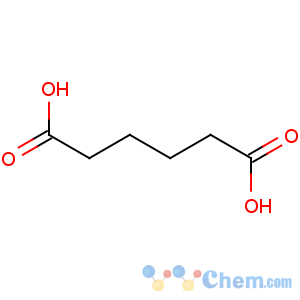Contact us
- Company Name: Zibo Eyuan Import & Export Co. Ltd
- Street: No 296 Liuquan Road
- City: Zibo
- Province/state: Shandong
- Country/region: China
- Contact Person: Mr.Kevin Cui
- Tel: 86-533-6288980
- Fax: --
- Email:
- Chat with supplier using
 jcren2008@gmail.com
jcren2008@gmail.com

adipic acid
-
- Product Nameadipic acid
- CAS No.124-04-9
- Purity>99.7%
- Min Quantity20000Kilograms
- Price0.4~1

 View Contact Detail
View Contact Detail
-
 Molecular Structure
Molecular Structure

- adipic acid
Detailed Description
Adipic AcidName: Adipic Acid CAS No: 124-04-9
Formula: C6H10O4 Molecular Weight: 146.14
Synonyms: hexanedioic acid
Solubility: very soluble in methanol, ethanol soluble in acetone slightly soluble in cyclohexane negligible in benzene, petroleum ether insoluble in acetic acid
Appearance: white crystals
Adipic acid is an aliphatic dicarboxylic acid with the formula (CH2)4(COOH)2. It is a white, crystalline compound with a slight acid taste and very faint odor. Its solubility is very low in water and soluble in organic solvents like alcohol and acetone. It is mainly as a precursor for the production of nylon.
Index Name Index
Appearance Premium Grade First Grade Qualified
White crystalline
powder White crystalline
powder White crystalline
powder
Content% (m / m) ≥ 99.70 99.70 99.50
Melting point℃≥ 151.5 151.5 151.0
ammonia water chroma,
platinum cobalt color number ≤ 5 5 15
Moisture % (m / m) ≤ 0.20 0.27 0.40
Ash mg / kg ≤ 7 10 35
Fe mg / kg ≤ 1.0 1.0 3.0
Nitrate content mg / kg ≤ 10.0 10.0 50.0
Applications:
Medical uses:
Adipic acid is used in the field of medicine incorporated for the formulation matrix tablets to obtain pH-independent release for both weakly basic and weakly acidic drugs. It is also been incorporated into the polymeric coating of hydrophilic monolithic systems to modulate the intragel pH, resulting in zero-order release of a hydrophilic drug. When this acid was used as a pore-forming agent without affecting release in the acidic media.
Adipic Acid uses in food
Significant amounts of adipic acid is used as a food ingredient as a flavorant and gelling aid. It is used in some calcium carbonate antacids to make them tart.
Other applications of Adipic Acid
? Polyamide polymers ? polyurethane systems
? organic synthesis ? plasticizers
? adhesives ? paints
? flexible and rigid foams ? detergency.
Other Uses
Adipic acid is approved as a food additive; however, the dominating use is for polymerisation. Different types of polyesters are produced with the help of adipic acid and they are used as a binder in paint, adhesives and for paper chemicals.
Adipic acid can also polymerise with polyalcohol such as ethylene glycol to polyester which often reacts further with ioscyanates to form polyurethanes.
Smaller esters of adipic acid are produced with alcohols with 8-10 carbon. These are called adipates. These are used as softeners in plastic (such as PVC) and as synthetic grease base oils (“synthetic esters”). In the latter use branched carbon chains are preferred since it gives better floating properties.